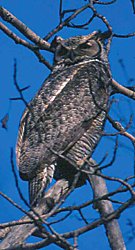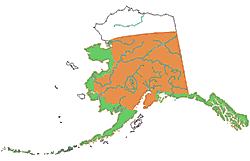Great Horned Owl
Bubo virginianus

Characteristics:
The Great Horned Owl is about 18-25” long. It has prominent ear tufts creating the “horned” appearance. Its large size and white throat, or “bib,” distinguish the Great Horned Owl. It is Alaska’s only large owl with ear tufts. The back of this raptor is various shades of brown and gray, mottled with white and buff. The underparts are white, tinted with buff and barred with dark brown or black. The facial disk is reddish, and the eyes are deep yellow. In flight, these owls are recognized by their large heads, very short necks and white throats.
Hunting Techniques and Prey:
Great Horned Owls rely mainly on their accute vision to detect prey and tend to hunt in the twilight hours near dusk and dawn. Snowshoe hares are their primary prey, but they will eat whatever they can get their talons on including small mammals, birds and even fish. Great Horned Owl populations fluctuate with changes in prey populations.
These birds live primarily in forested habitats. They invariably nest in old hawk, eagle, raven, or squirrel nests, but may occasionally nest in a large natural cavity of a hollow tree or cliff edge. They hunt in fields, meadows, old burns and along forest edges.
Voice:
Great Horned Owl Call (MP3 file 258 kB)
Usually give a five-noted, deep, resonant hoo, hoo-hoo,
hoo, hoo song but variations are common. Unlike other owl species, both male and female Great
Horned Owls sing. Intensive courtship calling occurs from December through March but they
regularly call throughout the year.

|
|
|
|
Common Uncommon |
 This information is from The Alaska Owlmanac: A guide to the identification, habits, and habitat of ten owl species found in Alaska.
This information is from The Alaska Owlmanac: A guide to the identification, habits, and habitat of ten owl species found in Alaska.
